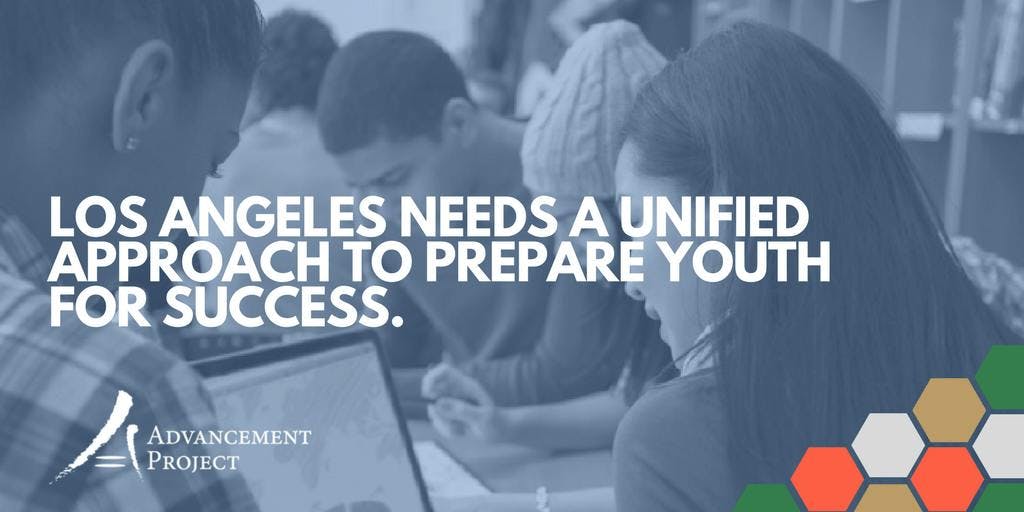Disconnected Youth in Los Angeles
By: Yvonne Liu, Data & Research Analyst
Today, Los Angeles City Councilmember Jose Huizar introduced a motion to form an Executive Task Force on Youth Development charged with developing a citywide approach to support the development of Los Angeles’ highest-need youth. Disconnected youth, who are young people not enrolled in school and also not employed in a job, are part of this population.
Also known as opportunity youth, this population is of concern to policymakers because the population is often tracked for the prison pipeline or another form of public support. Advancement Project California released a report, Blueprint for Youth Development Los Angeles, which looked at challenges facing Angeleno youth, including but not limited to disconnection. In the report, we compiled the first-ever estimates of disconnected youth in the age range of 16 to 24 at the city level.
About one out of every five 16 to 24 year old residents in Los Angeles city were disconnected from school and work (see Table 1). 68,947 or 14 percent of youth are not enrolled in school nor are they employed. Young women were disconnected at higher rates than men.
In addition, we looked at the breakdown of disconnection by race. A significant number of the disconnected youth were Latino, close to 65 percent. One of out every five Latinos between 16 and 24 both dropped out of school and didn’t have a job. The proportion of Black youth who were disconnected was even greater, almost one out of four. Together, this amounts to nearly 54,000 Black and Latino disconnected youth across Los Angeles.
Table 1: Disconnection of 16- to 24-Year-Old Youth in Los Angeles (2011-2015)
Total
Number Disconnected
Percent Disconnected
Total
492,984
68,947
14%
Male
248,510
32,712
13%
Female
244,474
36,235
15%
White
95,102
9,072
10%
Black
43,175
9,773
23%
Latino
294,146
44,490
15%
Asian or Pacific Islander
47,591
3,890
8%
Native American
367
45
12%
Other
1,917
336
18%
Two or More
10,686
1,341
13%
Source: American Community Survey, 5-year estimates, 2011-2015 obtained from IPUMS-USA, University of Minnesota, www.ipums.org
A report by Neeta Fogg and Paul Harrington (2016) defined human capital based on three characteristics: educational attainment, current labor force status, and prior work experience. Educational attainment is the highest level of schooling an individual completes. Current status in the labor force is whether the individual holds a job or is looking for a job, both considered part of the labor force. Those who are not looking for work or unemployed for a long period of time are not considered part of the labor force. Finally, prior work experience is any employment held by the individual in the past one to five years.
Table 2: Educational Attainment of 16- to 24-Year Old Disconnected and Connected Youth in Los Angeles (2011-2015)
Educational Attainment
Disconnected
Connected
Total
68,947
424,037
GED
3%
1%
HS Diploma
40%
17%
Some college or associate’s
18%
39%
Bachelor’s or more
8%
10%
Source: American Community Survey, 5-year estimates, 2011-2015 obtained from IPUMS-USA, University of Minnesota, www.ipums.org
We compared educational outcomes for disconnected with connected youth who are either still enrolled in school or who are employed (see Table 2). Disconnected youth were more likely to complete their high school studies with a GED diploma. Two out of five disconnected youth identified high school as their highest level of schooling, whereas almost the same proportion of connected youth achieved some college education or received an associate’s degree. More connected youth—one out of ten—graduated from college or went on to graduate and professional studies, while only 8 percent of disconnected youth accomplished the same.
Table 3: Labor Force Status of 16- to 24-Year Old Disconnected and Connected Youth in Los Angeles (2011-2015)
Status
Disconnected
Connected
Total
68,947
424,037
Employed
0%
50%
Unemployed
40%
6%
Not in labor force
60%
44%
Source: American Community Survey, 5-year estimates, 2011-2015 obtained from IPUMS-USA, University of Minnesota, www.ipums.org
Labor force participation for disconnected youth was just as dismal as educational attainment. Half of connected youth had a job, while none of the disconnected (by definition) were employed (see Table 3). Three out of five youth who were disconnected had dropped out of the labor force. They no longer looked for work or had been unemployed for one year or more. A disconnected youth was 1.5 times more likely to have dropped out of the labor force than to actively search for a job.
Table 4: Prior Work Experience of 16- to 24-Year-Old Disconnected and Connected Youth in Los Angeles (2011-2015)
Experience
Disconnected
Connected
Total
68,947
424,037
Employed within the past 12 months
26%
55%
Employed 1-5 years ago
17%
4%
Employed 5+ years ago or never
57%
40%
Source: American Community Survey, 5-year estimates, 2011-2015 obtained from IPUMS-USA, University of Minnesota, www.ipums.org
The chances of disconnected youth rejoining the labor force are slim, given their lack of schooling and past work experience. Close to three out of five youth who are disconnected have never been employed or last held a job more than 5 years ago (see Table 4). That is a greater proportion than those who were employed last year or within the last 5 years. Almost 40,000 youth in the city will experience grave challenges in navigating the labor market, having never been employed.
Clearly, youth who are disconnected from school and work are a serious challenge for Los Angeles. The Blueprint for Youth Development Los Angeles released last week recommends the city establish an office focused on resolving this and other challenges for young people. We hope the city follows the prescription as the need is great for the city’s future generations.
